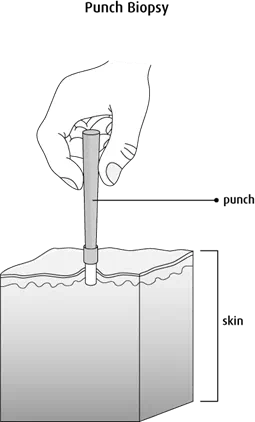Punch biopsy
A punch biopsy is a diagnostic test where a small, tube-shaped piece of skin and some other tissue underneath are removed using a sharp cutting tool. It can be done anywhere on the body. The tissue is then examined under a microscope.
Why a punch biopsy is done
With a punch biopsy, doctors are able to remove an area that includes all the layers of skin (epidermis, dermis and subcutaneous tissue). This is important when a full thickness of skin is needed to make a proper diagnosis and help plan treatment.
A punch biopsy is used to diagnose many types of cancer, including:
- non-melanoma skin cancer and melanoma skin cancer
- mouth (oral cavity)
- throat (oropharyngeal and hypopharyngeal)
- inflammatory breast cancer
- vaginal
- vulvar
It is also used to diagnose precancerous skin conditions and non-cancerous skin tumours or conditions.
A punch biopsy is often used for large tumours on the skin or on a thin, moist layer of tissue that lines some organs and cavities (mucosa).
How a punch biopsy is done
A punch biopsy is most often done in the doctor’s office or in a clinic as an outpatient. It usually takes about 15 minutes.
The skin is cleaned and a local anesthetic is used to freeze the area so you won’t feel any pain. The doctor stretches the skin with one hand and places the punch over the area with the other hand. The doctor pushes the punch down into the skin while twisting it until it has cut through all layers of skin. The tissue (called the biopsy sample) is lifted out with a needle and cut from the area with scissors.
The wound may be closed with 1 or 2 stitches if a large amount of tissue was removed. A bandage is placed over the wound. You can go home right after the biopsy is done.

Side effects
Side effects can happen with any type of test, but everyone’s experience is different. Most side effects of a punch biopsy are temporary. They may include:
- soreness or tenderness at the biopsy site
- a small amount of bleeding
- wound infection
- scarring
What the results mean
The biopsy sample is sent to a lab. A pathologist (a doctor who specializes in the causes and nature of disease) examines the sample. The pathology report describes the types of cells found in the sample and if the cells are normal or abnormal.
An abnormal result may mean:
- an infection
- a skin condition such as psoriasis or eczema
- a non-cancerous skin tumour such as a mole
- a precancerous condition of the skin such as actinic keratosis or lentigo maligna
- a cancer such as basal cell carcinoma or squamous cell carcinoma
If an abnormality or cancer is found, your doctor will decide if you need more tests, treatment or follow-up care. In some cases, a punch biopsy completely removes the tumour and no other treatment is needed.
Your trusted source for accurate cancer information
With support from readers like you, we can continue to provide the highest quality cancer information for over 100 types of cancer.
We’re here to ensure easy access to accurate cancer information for you and the millions of people who visit this website every year. But we can’t do it alone.
Every donation helps fund reliable cancer information, compassionate support services and the most promising research. Please give today because every contribution counts. Thank you.
